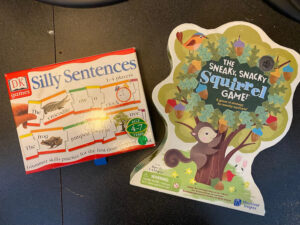
There are many reasons why I acquire a new therapy game. Sometimes it’s to fill in a gap in the range of games I have, sometimes it’s for a specific student (other games are non-productive with this student), sometimes it’s to replace a favorite but worn-out game. When I’m looking for something different, there are several factors I take into consideration.
Look for games that have interactivity or cooperative learning
Look for games that have branches of activity. For example, a board game has you draw a card when you land on a certain space or square. This takes the game in a new direction, but allows the therapist a chance to inject a therapy activity. For example, a speech therapist may have the child make up a sentence using a target word or target sound on which they are working BEFORE they draw the card.
Look for unique games
HABA, Ravensburger and Peaceable Kingdom incorporate moveable pieces, cooperative learning, and different characters and themes. This makes therapy more interesting, interactive, and creative. Think out of the box when choosing a game for therapy. Any game can be adapted to meet therapy goals.
Look for special interest games
Kids often have areas of particular interest. If they LOVE dinosaurs, they will be interested in playing a dinosaur-themed game. Or it could be horses, or cars and trucks and construction vehicles, pets, or flowers.
Look for popular characters
As with Special Interests, sometimes kids strongly identify with popular, copyrighted characters. It could be Thomas the Tank Engine, or SpongeBob SquarePants, Pete the Cat, or My Little Pet Shop. Many standard matching games and Bingo games are issued with copyrighted characters, so you know how to play the game already. Games that have those characters can be motivating to students. Again vocabulary or articulation cards can be included. Adjust the game as needed to meet therapy goals.
Look for developmentally appropriate games
There are certain development skills that are milestones for kids. Look for games that utilize that skill: if they don’t have the skill, you can develop it; if they show they have the skill, you can reinforce and strengthen it. Pincer grasp for your children, use a game that incorporates tweezers. Fine motor dexterity, look for a game uses small pieces like a Lite-Brite or Legos. Or lacing cards.
And there is always Personal Recommendation from co-workers and colleagues. Therapists (speech, occupational, and physical) can adjust a game to meet the students needs. Look for multi-use games that incorporate motor, direction-following, and communication skills. Using games like Sneaky Snacky Squirrel, or block games that have moveable pieces, tweezers, or building parts will improve dexterity, and hand strength. Games that incorporate patterns, building, turn-taking and direction-following may be effective for occupational therapists. Games that incorporate vocabulary, sound development, and direction-following may be effective for speech therapists. A physical therapist can adjust games to include balance, running, jumping. Games like Feed the Woozle, Twister, The Floor is Lava are great choices for physical therapy.
Check out the variety of used games available at TherapyGameXchange.com
